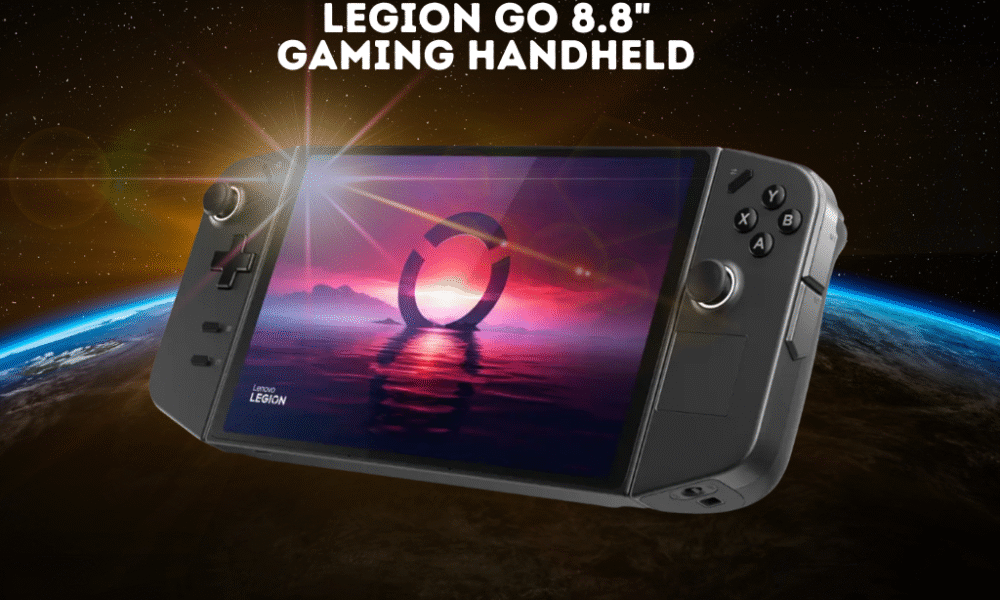Gaming
Lenovo Legion Go Review: A Big Screen Contender in the Handheld Arena

Lenovo Legion Go
The handheld gaming PC market is heating up, and Lenovo has entered the fray with a device that’s hard to ignore. The Legion Go, with its massive 8.8-inch QHD+ display and detachable controllers, is a bold statement. But does bigger always mean better? We put the Legion Go through its paces to see if it can carve out a space for itself against the likes of the Steam Deck and the Asus ROG Ally.
Design and Display: A Feast for the Eyes
The first thing you’ll notice about the Legion Go is its sheer size. It’s a hefty device, weighing in at 854g with the controllers attached. While this makes it less portable than some of its rivals, the payoff is the stunning 8.8-inch QHD+ (2560 x 1600) IPS display. With a 144Hz refresh rate and 500 nits of brightness, games look absolutely gorgeous. The colors are vibrant, and the high refresh rate makes for incredibly smooth gameplay when you can hit the frame rates.
The build quality is solid, with a sturdy kickstand that’s a clear advantage over the competition. The design is reminiscent of the Nintendo Switch, with detachable “TrueStrike” controllers that slide off the sides of the screen.
Controllers and Features: Innovative but Imperfect
The detachable controllers are the Legion Go’s most innovative feature, but also its most divisive. On the one hand, they offer a level of versatility not seen in other handhelds. You can detach them and play with the screen propped up on a table, which is a more comfortable way to play for extended sessions. The right controller even has a “FPS Mode” that turns it into a vertical mouse, which is a neat trick for first-person shooters.
On the other hand, the process of detaching and reattaching the controllers is a bit clunky. The controllers themselves are large, which might be uncomfortable for those with smaller hands. While they are packed with buttons, including assignable grip buttons and a trackpad, the layout can take some getting used to.
Performance: A Powerful but Demanding Beast
Under the hood, the Legion Go is powered by the same AMD Ryzen Z1 Extreme chip found in the Asus ROG Ally. This is a powerful processor that can handle most modern games at respectable settings. However, the high-resolution screen is a double-edged sword. While it looks fantastic, pushing games at the native 1600p resolution is a tall order for the hardware, and you’ll often need to lower the resolution to 1200p or 800p to achieve a stable 60fps in demanding titles.
The software experience is another area where the Legion Go has room for improvement. Lenovo’s Legion Space launcher is a work in progress and can feel a bit unpolished compared to the seamless experience of SteamOS. You’re still interacting with Windows 11, which isn’t the most touch-friendly operating system.
Battery life is, as expected for a powerful handheld, a weak point. You’ll be lucky to get more than a couple of hours of gameplay in demanding titles, so you’ll want to keep the charger handy.
Verdict: Ambitious, Flawed, but Full of Potential
The Lenovo Legion Go is a fascinating device. It’s an ambitious attempt to create the ultimate handheld gaming PC, with a best-in-class display and innovative features. However, its size, clunky software, and demanding screen mean it’s not without its flaws.
For gamers who prioritize screen size and versatility, the Legion Go is a compelling option. The ability to detach the controllers and use the device as a portable gaming monitor is a game-changer for some. However, those looking for a more polished and portable experience might be better served by the Steam Deck or the Asus ROG Ally.
The Legion Go is a strong first effort from Lenovo and a sign of exciting things to come in the handheld gaming space. With some software refinements and a more ergonomic design, the next iteration could be a true king of the handhelds.
Pros:
- Stunning 8.8-inch QHD+ 144Hz display
- Powerful AMD Ryzen Z1 Extreme processor
- Detachable controllers offer versatile play styles
- Sturdy built-in kickstand
- Two USB-C ports
Cons:
- Heavy and bulky
- Legion Space software is unpolished
- Detaching and reattaching controllers can be clunky
- Poor battery life
- Gaming at native resolution is often not feasible
The one stop for all your gaming gadget reviews